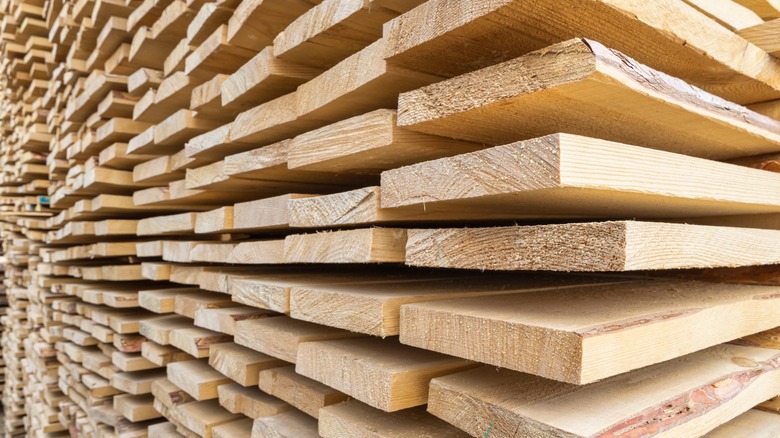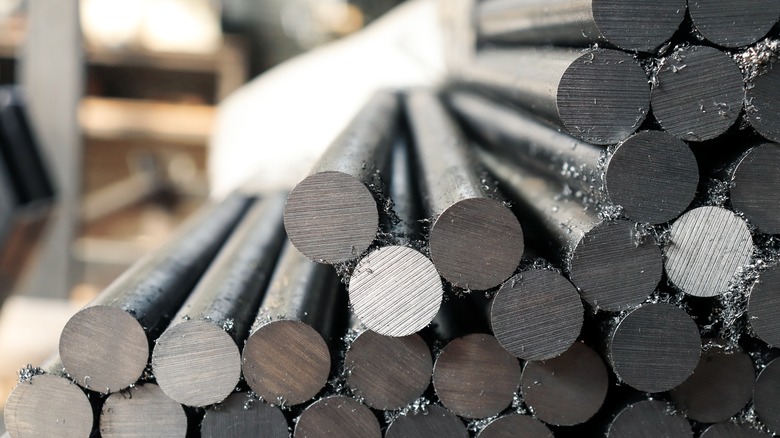How Much More Expensive Did DIY Materials Really Get With The Pandemic?
Supply chain issues are built from a complex series of cascading failures in the global system of trade and the movement of goods. When supply chain issues have strangled markets in the past, consumers eventually found one specific failing or back up that could help explain all of the rest. The New York Times notes that the current supply chain strain is almost entirely built off of the unique economic, social, and healthcare-related pressures that the coronavirus pandemic imposed on the entire world.
Most visibly, when the pandemic began to spread around the world, people were forced to remain indoors and this severely impacted the financial fortunes of many businesses — particularly small businesses. Typically, when economic conditions begin to shift, businesses enjoy weeks or months of lead time that allow them to change their procurement processes in response. Yet, the pandemic did not afford the global marketplace this luxury. Instead, people everywhere were rushing to the store to buy weeks' worth of food, toilet paper, and other staple products that they might run out of in the event of a sudden positive COVID-19 test.
In the same way that consumers changed their spending habits in a sudden shock to the system, employers also had to adapt to this new economic regime. Layoffs, furloughs, reduced schedules, and work from home orders all sent consumer sentiment spiraling, while also debilitating productive capacity both at home and abroad.
Wood pulp products (used in paper applications) rose by roughly 22%, on average
The supply chain has experienced a number of knocks, and some of the most obvious products affected are those materials manufactured and transported across long distances from national hubs or imported from overseas (traveling vast distances by plane or ship in the process). Wood pulp products have seen a considerable spike in price. GAMA Healthcare reports that these price changes are similar to those that affected toilet paper in the early days of the pandemic.
Toilet paper outages came as a result of the specialized fabrication processes used to create this essential paper product. Factories simply couldn't reconfigure manufacturing equipment to produce increased volumes of toilet paper instead of other products created on the floor in tandem with this one asset. Similarly, with people remaining at home for many more hours per day, using a greater volume of toilet paper at home rather than in the workplace, led to a substantial increase in demand (alongside a level of consumer panic). The results saw a sharp decline in available stocks of toilet paper and other seemingly unrelated products on store shelves. What's less obvious to the average consumer is the fact that wood pulp used to create paper materials of all kinds was influenced by this sudden consumer run on toilet paper. An increase in demand here made its way back up the supply chain, driving prices of the raw material to significant new highs, and causing everything from cardboard to tissue paper and sanitary items to jump in price.
The increase in cardboard material is particularly important for DIYers. As a result of continued supply chain problems across the board, the price of nearly everything has increased, but packaging often plays a silent role in the inflation of consumer goods and DIY essentials. With a rise in cardboard and paper products, printing user manuals and instruction booklets, packaging goods, and even sourcing these raw materials became more expensive and, in some regards, far more challenging. Put simply, wood pulp is a crucial core material in the fabrication and movement of just about every item you might buy in the modern marketplace.
Certain lumber costs quadrupled during the pandemic
Lumber is another big segment of the DIY marketplace. To build just about anything at home, you'll need a range of wood products, but increases in both hardwood and softwood lumber have sent DIY and commercial construction projects on an expensive trajectory. The USDA Forest Service reports that American lumber efforts have been stymied by outages in both hiring and retaining experienced professionals. During the pandemic, labor forces have seen drastic fall off through workers coming down with the virus and others quitting or losing their jobs as a result of worsening economic conditions. This sudden swing in the workforce led to the downturn in production of both raw material and milled lumber that would eventually be bound for home improvement store shelves. As the pandemic economy continued on, demand for lumber and a distinct lack of supply increased the price. According to the USDA Forest Service, wholesale plywood rose from $400 to $1,500 per thousand square feet, and retail prices saw a similar percentage increase, rising to $48 per sheet.
As well, the lumber industry suffered from a lack of new talent making its way into mills, transportation careers, and lumber sourcing areas. Even with increases to wages in this sector, the industry as a whole has struggled to recruit new workers which has translated into an elongated downturn in supply. These pricing changes can be seen in both hardwood and softwood resources that homeowners and professionals alike require for their construction efforts around the home. Whether you're considering building a new deck for your backyard, installing new wooden windows to maintain a period-correct aesthetic, or looking to build custom furniture for inside the home, you're likely to face increased costs for wood based materials of all types.
Iron and steel increased substantially during the pandemic
Steel, iron, copper, and many other essential metals have seen dramatic increases in their pricing throughout the pandemic. Western States Metal Roofing reports that early in the pandemic many steel mills were forced to close temporarily as a result of public health and safety concerns, and, in many instances, remained shuttered because of labor shortages that have affected virtually all industrial sectors. Western States Metal Roofing also notes that in the second half of 2020, steel prices per ton doubled from $440 to $900, and have since risen even higher. This has come about because of these continued worker shortages and facility closures in the short term, and a further continuation of chaos in the transportation sector, which has led to the persistence of high prices for shipping and uncertainty about timelines for delivery. Combined with an increased demand for products fabricated from iron, steel, and other crucial metal resources, consumers can expect to see substantial increases in all things metal.
Many homeowners are bearing the brunt of these cost increases when it comes to the fabrication of things like windows and doors. Likewise, external elements may require the use of fabricated metal features, like railings on an exterior deck or roof terrace. Another key space in which homeowners have seen a significant increase in pricing is with metal roof installations. A metal roof can last for much longer than a traditional shingle or tile roof, but with price increases in iron and steel, it has become far more difficult to source raw products to create the metal sheets adorning these types of roofs. This difficulty has translated into significantly increased costs for homeowners looking to replace their existing home covering.
Specific steel products like screws, nails, and other hardware saw an increase of around 30%
The iron and steel cost increase can be seen in specific products that are used across the board, not just in specialized installations like roofs or metal fencing. The Bureau of Labor Statistics reports that common products, like nails and screws, have seen a jump in price of about 30% as a result of the coronavirus pandemic. Just like other metal products used in home improvement and building, fabricating screws, nails, and other fastening equipment require a consistent supply of the raw material in question. With a downturn in productivity at steel mills across the country, it's only natural that all types of end products have seen a dramatic reduction in output from manufacturing centers. Once again, an increased demand to retrofit homes in coordination with new usage requirements (stemming from increased time spent working from home and remaining in the property throughout weekend) saw homeowners seeking to buy significantly more home improvement products and tools. The combination of decreased supply and dramatically increased demand has sent fastening materials and the tools themselves on a substantial price rise throughout this time of supply chain uncertainty.
Another key aspect of these more consumer-forward products lies in the fact that they are generally less important than more commercialized infrastructure needs. For instance, early in the pandemic, federal and local authorities were buying up vast reserves of face masks to supply frontline and other health care workers with this crucial tool as they encountered infections directly. Everyday consumers also required masks, but when considering the strained supply of these products, it was clear that frontline medical professionals represented the greater need and were therefore prioritized in sourcing. The same can be said for the fabrication of steel and other metal products across the entire sector of metalworks.
Granite and other cut stone products have seen increases in delivery time and cost
An additional noticeable downturn in productivity can be seen in the granite and cut stone industry. Connecticut Stone reports that labor shortages and the cost to move goods have each contributed to significant delays in the procurement of stone for countertops and other applications (to the tune of about four to eight weeks), as well as an increase in pricing across the board. The coronavirus pandemic has put a strain on workforces of all types, and with much of the granite used in global home improvement efforts coming from Brazil, Russia, or China, sourcing and shipping these enormously large and heavy stone slabs has become increasingly difficult.
One issue that the cut stone industry is facing is a lack of shipping containers for use in moving these substantial products. With delays and a rise in cost affecting the shipping industry on a vast scale, moving luxury items (as opposed to essential goods such as food, medical equipment, and other products) has become increasingly more expensive and often much slower. All this means that homeowners in the midst of a home improvement project that will make use of cut stone veneers, facings, or countertops will have to plan for a much longer time to deliver as they continue through the upgrade. Connecticut Stone also reports that the cut stone industry is facing supply chain issues of its own, leading to essential equipment required for cutting, polishing, and other components of the finishing process to be slow in delivery and more expensive as well. All this leads to an increase in cost and a much longer timeline for the completion of any installation project.
Services were impacted too, with plumbing costs increasing by more than 3%, on average
A last component of home improvement that has been significantly altered by the coronavirus pandemic is the use of hired contractors and service professionals. The Bureau of Labor Statistics notes that plumbing services have increased by more than 3% for homeowners. It's also worth noting that hiring a plumber, or any other type of contractor or service technician, has become far more difficult with the increased concern over public safety and individual health. Meeting in person has required unique safety standards that, even when followed to the letter, still place professional tradespeople at risk (and homeowners, too). This means that plumbers, electricians, general contractors, and others in the service industry have been more reluctant than ever to take on meetings with prospective clients. With greater uncertainty and concern over health, and a reduction in physical availability, it's only natural that the price for these services has gone up alongside the general scarcity imposed by the pandemic.
Alongside a reluctance to take meetings and perform extensive pre-contract work on a homeowner's property, the material requirements of these professionals have increased across virtually all sectors, from PVC and metal piping, to wiring, lumber, and screws. These costs are, of course, passed on to homeowners and have also played a role in the rising price to hire a professional for a specific task or a wider array of update requirements.
Pandemic outages have influenced supply chain resiliency in a number of ways
One area where pandemic-related supply chain outages have really influenced consumer planning and long term spending is in the DIY space. Homeowners looking to improve upon their properties have found an immense challenge standing in their way. Throughout the pandemic, scheduling consultations or work with a contractor, electrician, roofer, or any other service professional was wrought with concerns over safety, delays in procuring materials, and potential setbacks in project timelines due to unavoidable staffing issues.
Materials and labor aren't the only costs that are skyrocketing as a result of the pandemic, however. The White House reports that pandemic-related financial realities have impacted sales on new homes and cars, driving home prices to their highest level in 14 years, and cars to their highest in 15. This is due to a unique instance of competing factors. On one hand, the years spent in a variety of lockdown, self-isolation, and social distancing phases has led to an accumulation of savings for many Americans. From the use of financial grants handed out by the federal government to a reduction in typical spending categories that weight heavily on normal budgeting processes (like eating out at restaurants or going on vacation), people generally have more cash to spend. This has driven spending on certain items (like cars and homes) to new levels, increasing sellers' ability to up-charge for these commodities. In the case of automobile sales, this has produced other issues that can be drawn back to supply chain strain. For instance, automakers have seen an increasing shortage of essential microchips, which has translated into shortages of any type of product that requires these elements (via Reuters).
Supply chain troubles have influenced all manner of business operations. Accenture reports that 94% of Fortune 1000 companies have experienced supply chain disruptions resulting directly from the coronavirus pandemic; what's more, more than half of these companies (55%) have or will downgrade their future growth estimates. The Harvard Business Review suggests that brands will have to square localized needs with the widespread adoption of lean manufacturing for maximum cost reduction under normal circumstances, leading to a revolutionized means of moving goods around the world and ensuring supply chain resiliency.
Other events during the pandemic led to increased systemic stress as well
While the pandemic itself strained supply chains to their breaking point — and often beyond — a number of other global issues have continued to threaten a return to a state that might be considered normal. In March 2021, the ultra-large container vessel (ULCV) Ever Given was blown off its narrow course through the Suez Canal and blocked this essential choke point for six days. Supply chain derailments resulting from container ship blockages, crashes, or malfunction happens on occasion, but during a time of already high stress on the global movement of goods, a sudden outage in movement through this vastly important waterway pushed supply chains to the brink. In many ways, this nearly weeklong blockage is still sending ripples through the global transportation sector (via Foreign Policy).
What's even more startling about this downturn in worldwide trade is the ease with which a single event can create such calamity. Foreign Policy reports that one thing concerning governments everywhere is the potential for global disruption as a result of intentional sabotage. Pirates and international terrorists have and continue to target large marine vessels for their own purposes. A successful attack in a crucial location like the Suez Canal, or other bottleneck locations such as Panama, Malacca, or Oresund (via Port Economics, Management and Policy), could send global trade reeling once again. On a less malicious note, inexperience or sheer bad luck can yield the same result. Foreign Policy estimates that one key factor in the resiliency (or vulnerability) of global trade lies in the reliance on these enormous vessels, shrinking the movement of goods onto fewer and fewer ships that must maintain perfection (or perhaps a heightened sense of security and defensive capability).
Another key issue affecting supply chain resiliency lies in global conflict of a more visible nature. The war in Ukraine has significantly influenced the movement of goods over land and by sea, and created uncertainty when it comes to gas and oil resources (via J.P. Morgan). Energy prices have been on the rise already, but heading into winter, nations across Europe are experiencing skyrocketing energy bills and a hardship in sourcing heat and electric power without the flow of natural gas from Russia.








